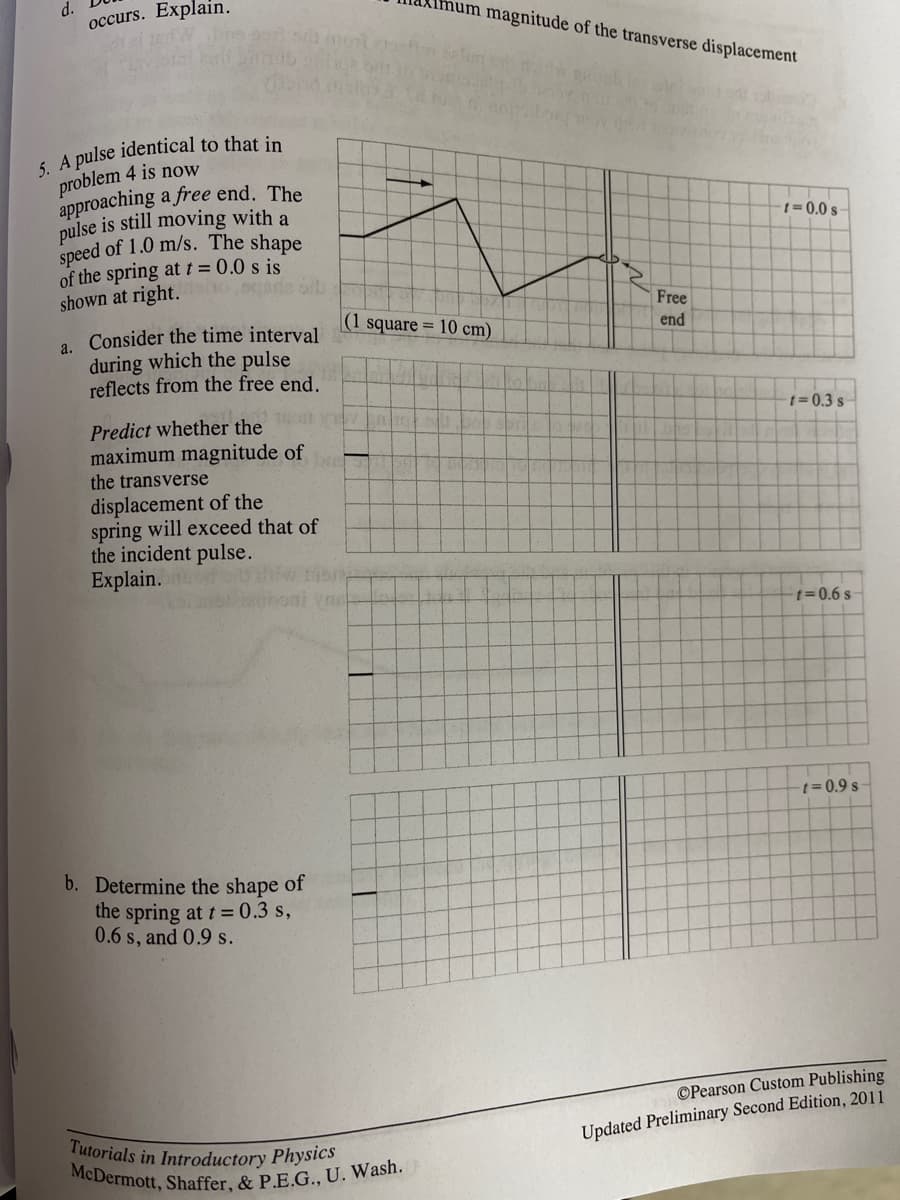speed of 1.0 m/s. The shape 5 A pulse identical to that in problem 4 is now approaching a free end. The pulse is still moving with a t0.0 s of the spring at t = 0.0 s is shown at right. Free (1 square = 10 cm) a. Consider the time interval during which the pulse reflects from the free end. end t= 0.3 s Predict whether the maximum magnitude of the transverse displacement of the spring will exceed that of the incident pulse. Explain. t=0.6 s %3D0.9 s b. Determine the shape of the spring at t = 0.3 s,
speed of 1.0 m/s. The shape 5 A pulse identical to that in problem 4 is now approaching a free end. The pulse is still moving with a t0.0 s of the spring at t = 0.0 s is shown at right. Free (1 square = 10 cm) a. Consider the time interval during which the pulse reflects from the free end. end t= 0.3 s Predict whether the maximum magnitude of the transverse displacement of the spring will exceed that of the incident pulse. Explain. t=0.6 s %3D0.9 s b. Determine the shape of the spring at t = 0.3 s,
University Physics Volume 1
18th Edition
ISBN:9781938168277
Author:William Moebs, Samuel J. Ling, Jeff Sanny
Publisher:William Moebs, Samuel J. Ling, Jeff Sanny
Chapter15: Oscillations
Section: Chapter Questions
Problem 55P: Suppose you have a 0.750-kg object on a horizontal surface connected to a spring that has a force...
Related questions
Question
5a-5b please

Transcribed Image Text:McDermott, Shaffer, & P.E.G., U. Wash.
occurs. Explain.
d.
num magnitude of the transverse displacement
problem 4 is now
approaching
pulse is still moving with a
speed of 1.0 m/s. The shape
of the spring at t = 0.0 s is
shown at right.
a free end. The
t%3D0.0 s
Free
|(1 square = 10 cm)
a. Consider the time interval
during which the pulse
reflects from the free end.
end
t= 0.3 s
Predict whether the
maximum magnitude of
the transverse
displacement of the
spring will exceed that of
the incident pulse.
Explain.
t= 0.6 s-
%3 0.9 s
b. Determine the shape of
the spring at t = 0.3 s,
0.6 s, and 0.9 s.
©Pearson Custom Publishing
Tutorials in Introductory Physics
Updated Preliminary Second Edition, 2011
Expert Solution
This question has been solved!
Explore an expertly crafted, step-by-step solution for a thorough understanding of key concepts.
This is a popular solution!
Trending now
This is a popular solution!
Step by step
Solved in 2 steps with 2 images

Knowledge Booster
Learn more about
Need a deep-dive on the concept behind this application? Look no further. Learn more about this topic, physics and related others by exploring similar questions and additional content below.Recommended textbooks for you

University Physics Volume 1
Physics
ISBN:
9781938168277
Author:
William Moebs, Samuel J. Ling, Jeff Sanny
Publisher:
OpenStax - Rice University

Physics for Scientists and Engineers, Technology …
Physics
ISBN:
9781305116399
Author:
Raymond A. Serway, John W. Jewett
Publisher:
Cengage Learning

Principles of Physics: A Calculus-Based Text
Physics
ISBN:
9781133104261
Author:
Raymond A. Serway, John W. Jewett
Publisher:
Cengage Learning

University Physics Volume 1
Physics
ISBN:
9781938168277
Author:
William Moebs, Samuel J. Ling, Jeff Sanny
Publisher:
OpenStax - Rice University

Physics for Scientists and Engineers, Technology …
Physics
ISBN:
9781305116399
Author:
Raymond A. Serway, John W. Jewett
Publisher:
Cengage Learning

Principles of Physics: A Calculus-Based Text
Physics
ISBN:
9781133104261
Author:
Raymond A. Serway, John W. Jewett
Publisher:
Cengage Learning

College Physics
Physics
ISBN:
9781285737027
Author:
Raymond A. Serway, Chris Vuille
Publisher:
Cengage Learning

Classical Dynamics of Particles and Systems
Physics
ISBN:
9780534408961
Author:
Stephen T. Thornton, Jerry B. Marion
Publisher:
Cengage Learning

College Physics
Physics
ISBN:
9781305952300
Author:
Raymond A. Serway, Chris Vuille
Publisher:
Cengage Learning